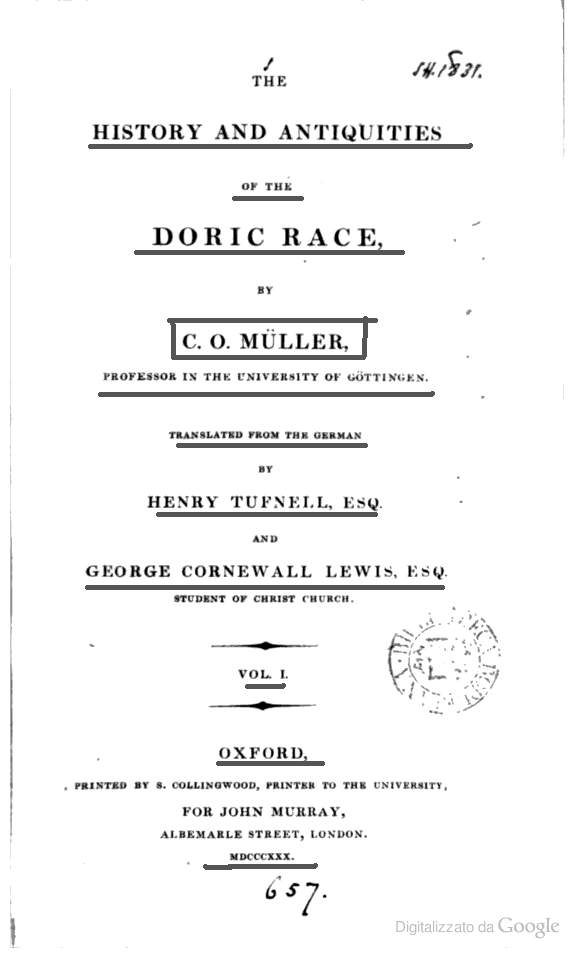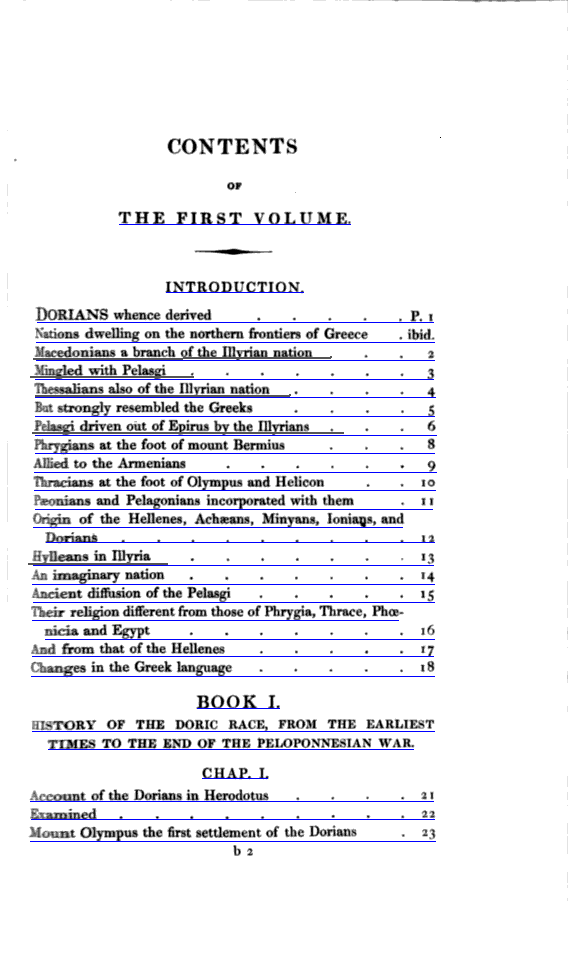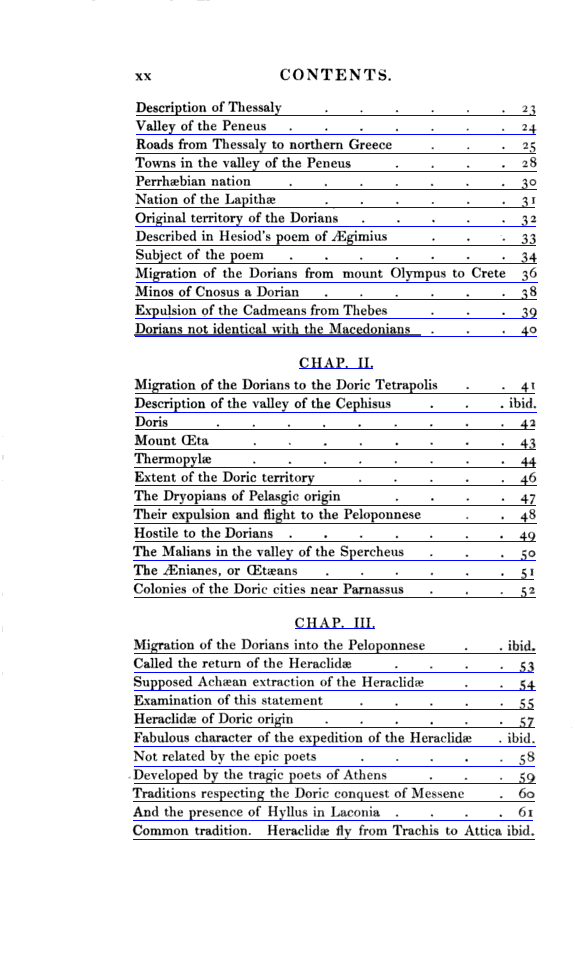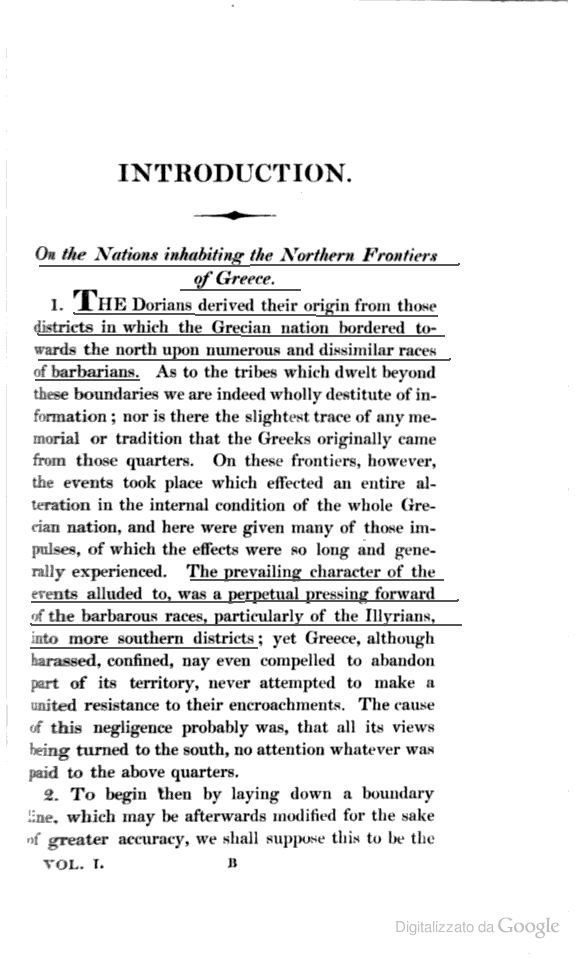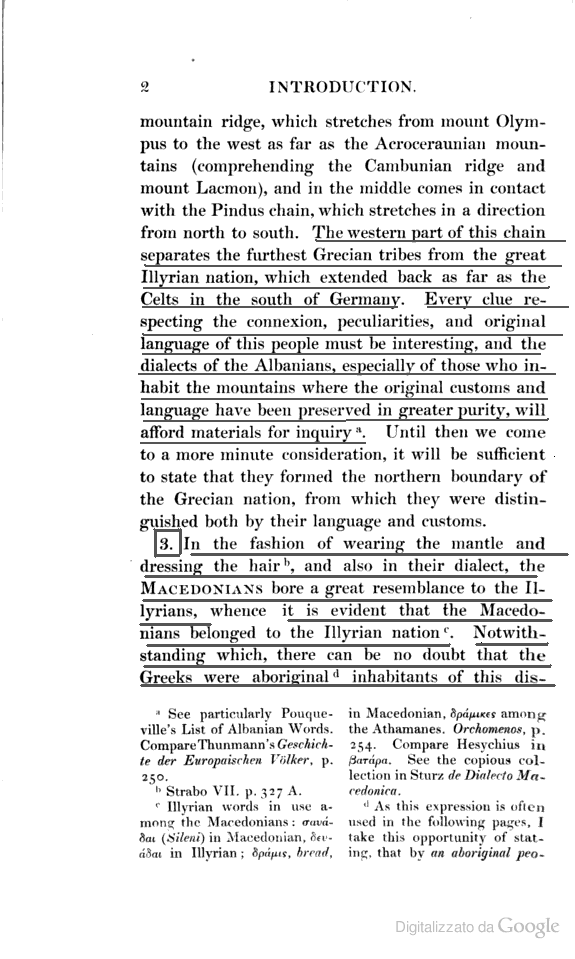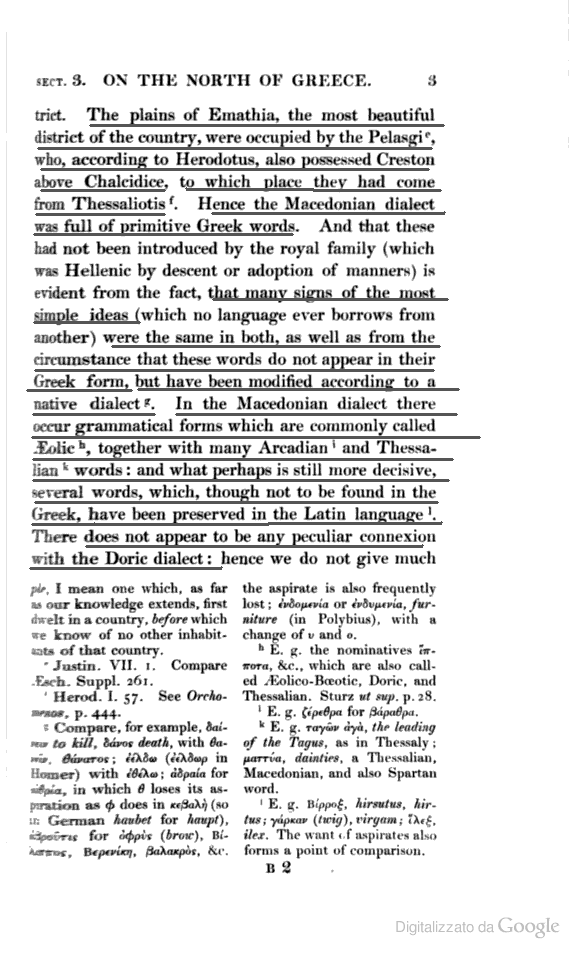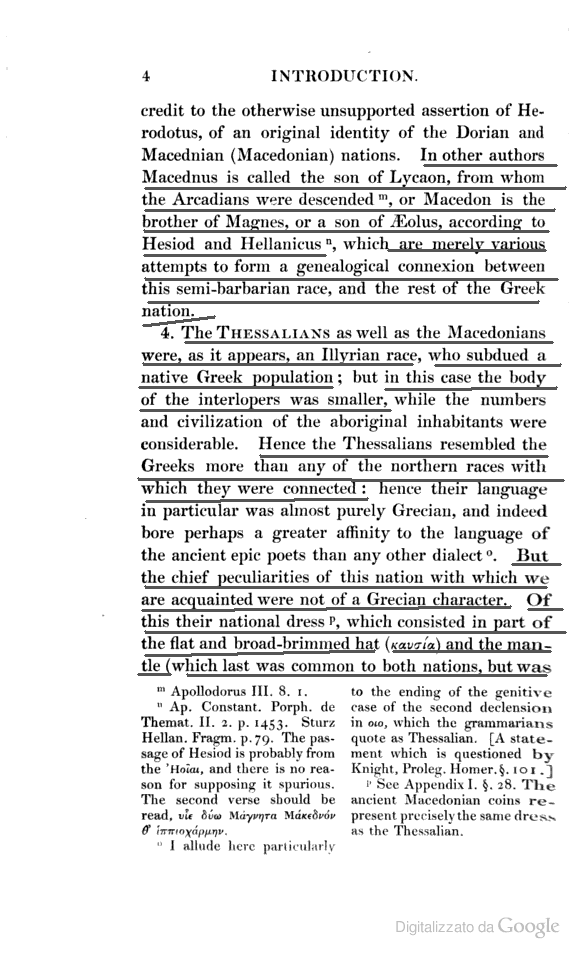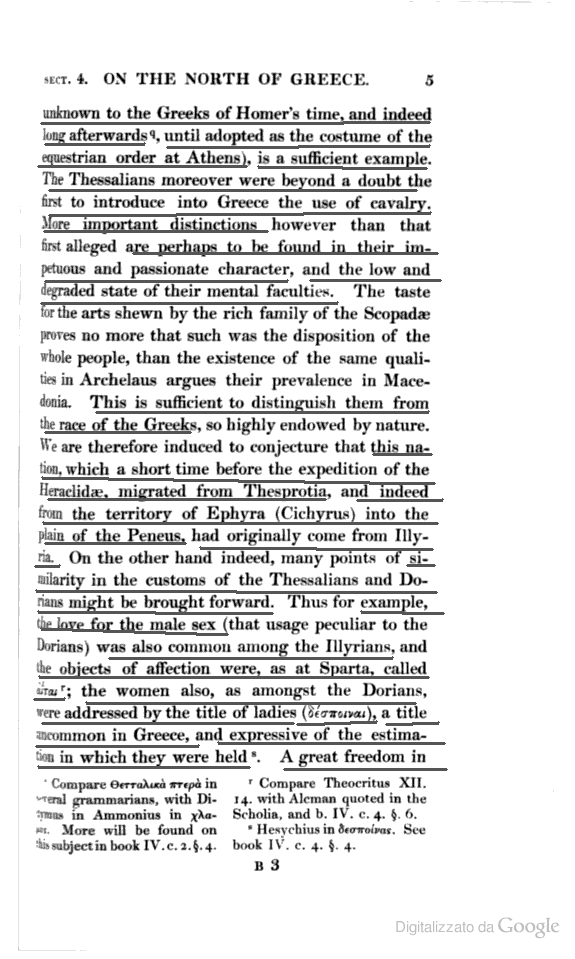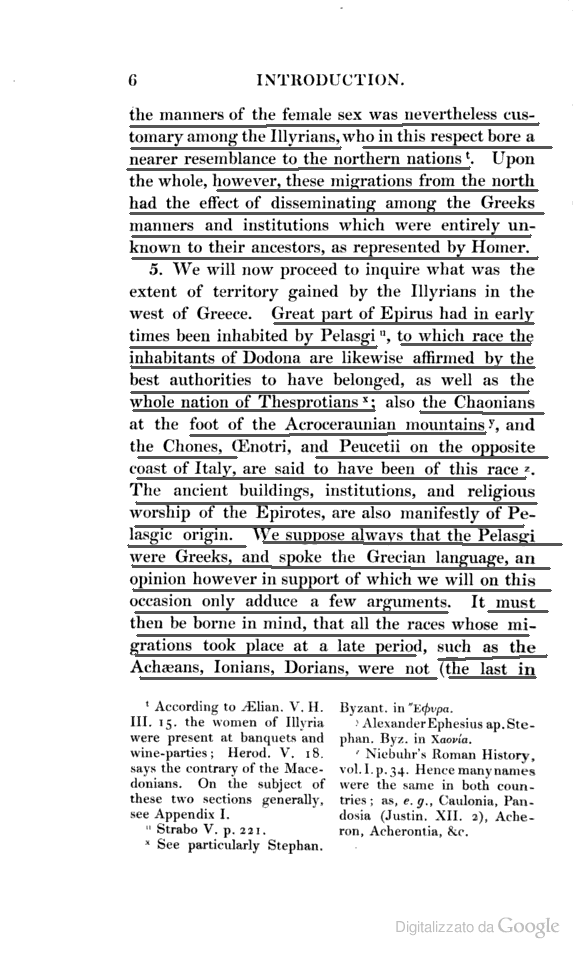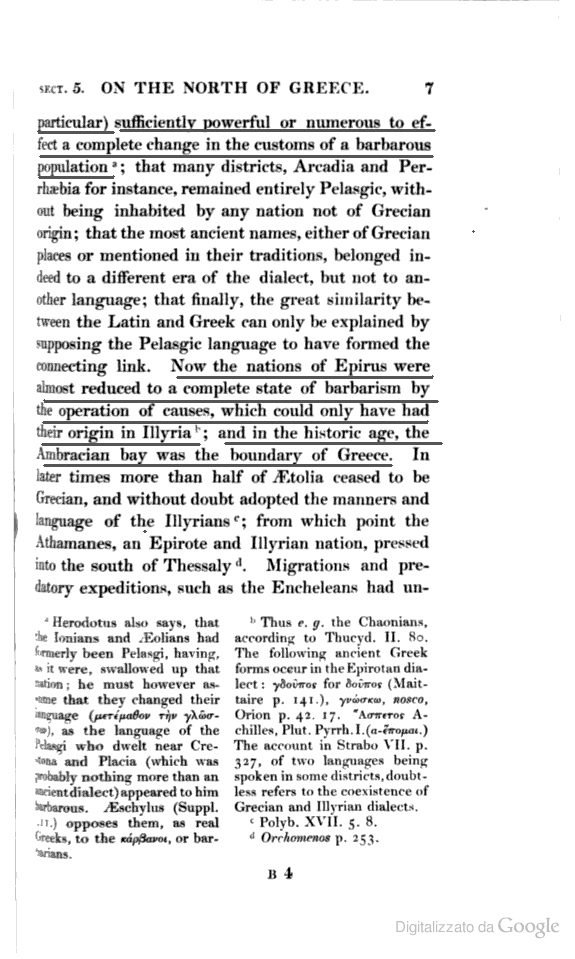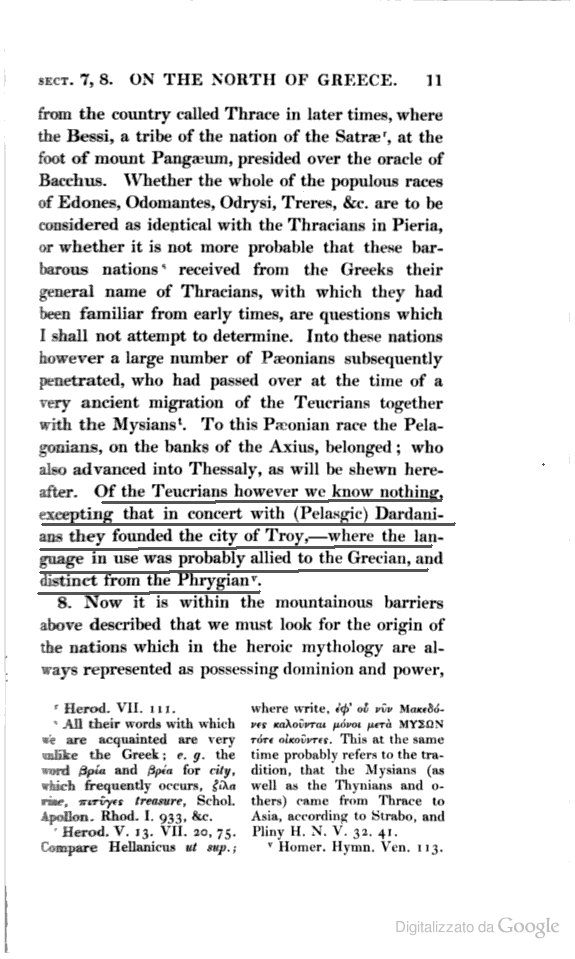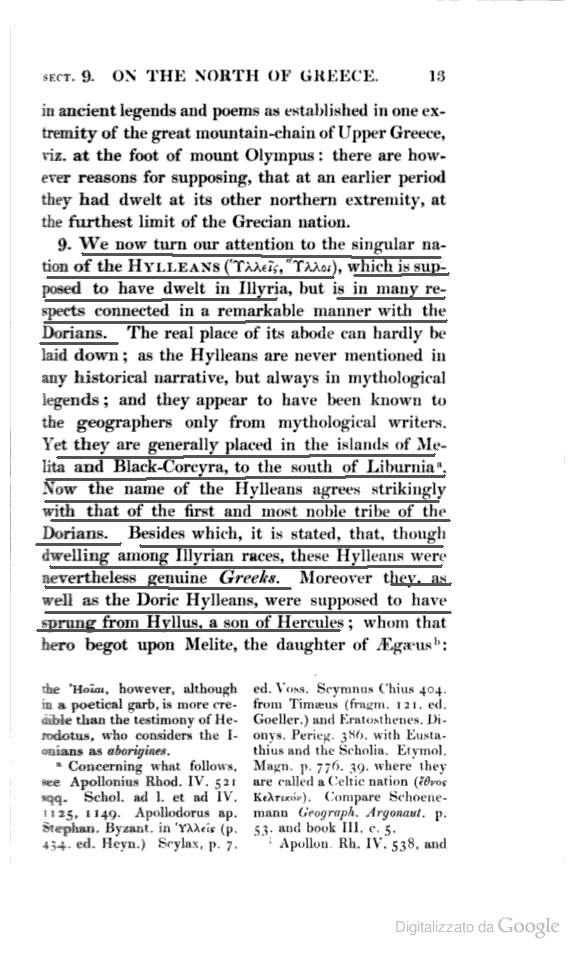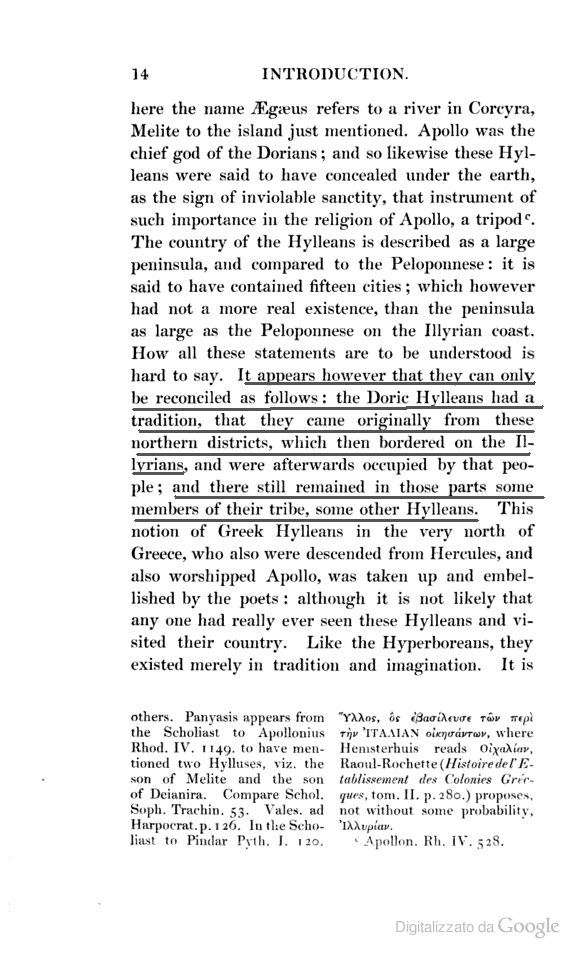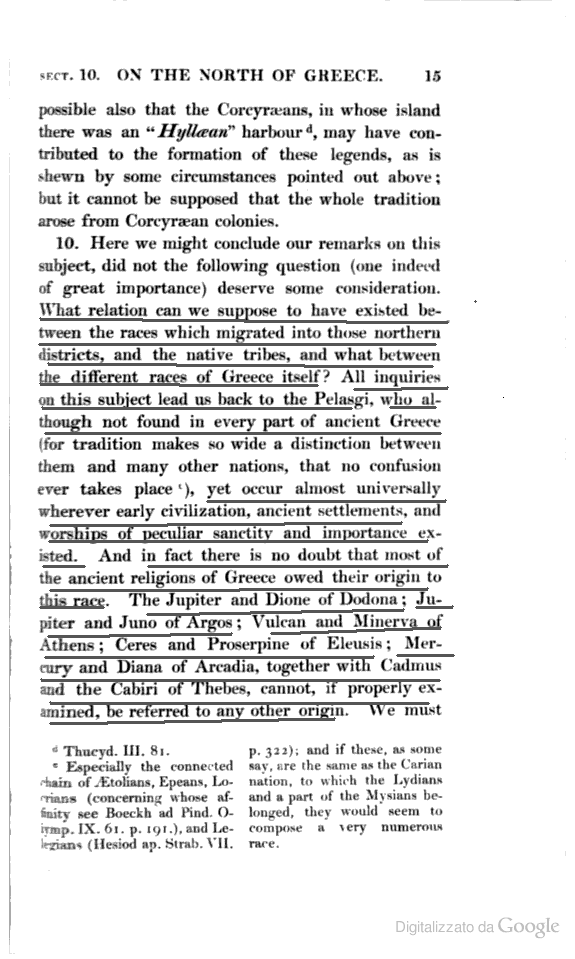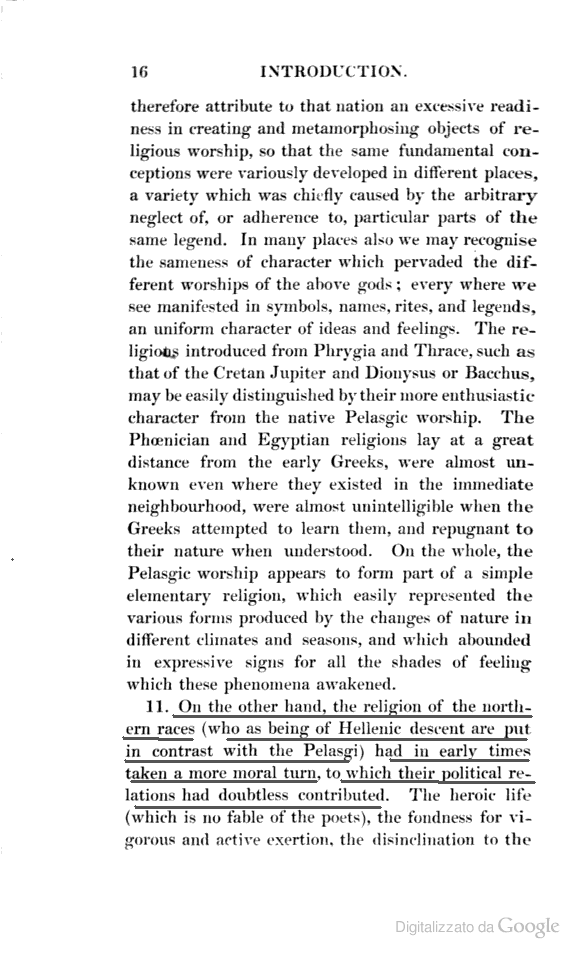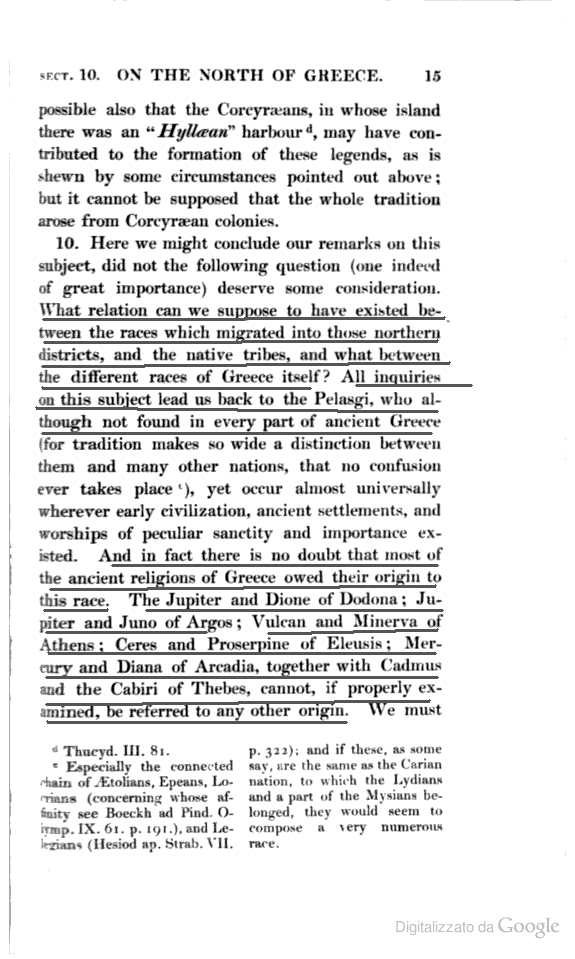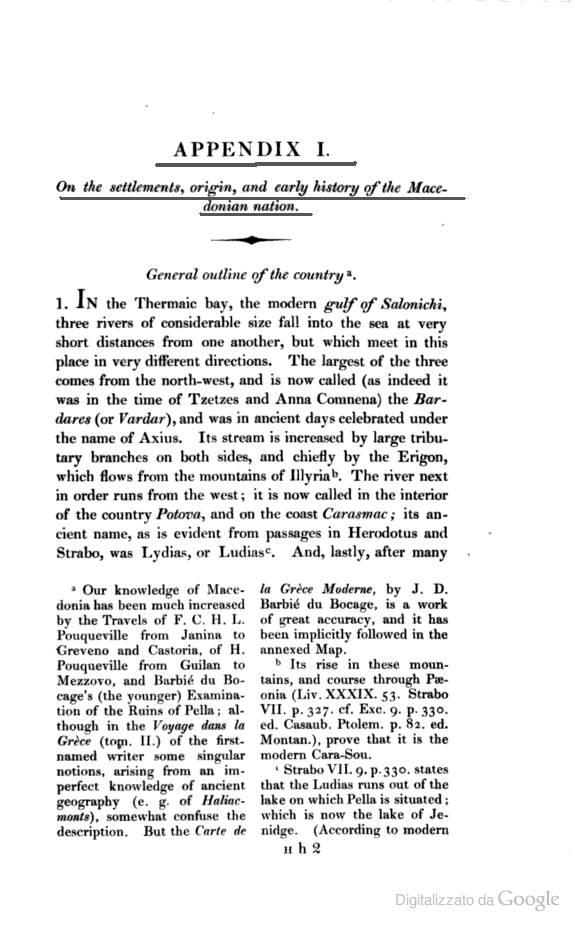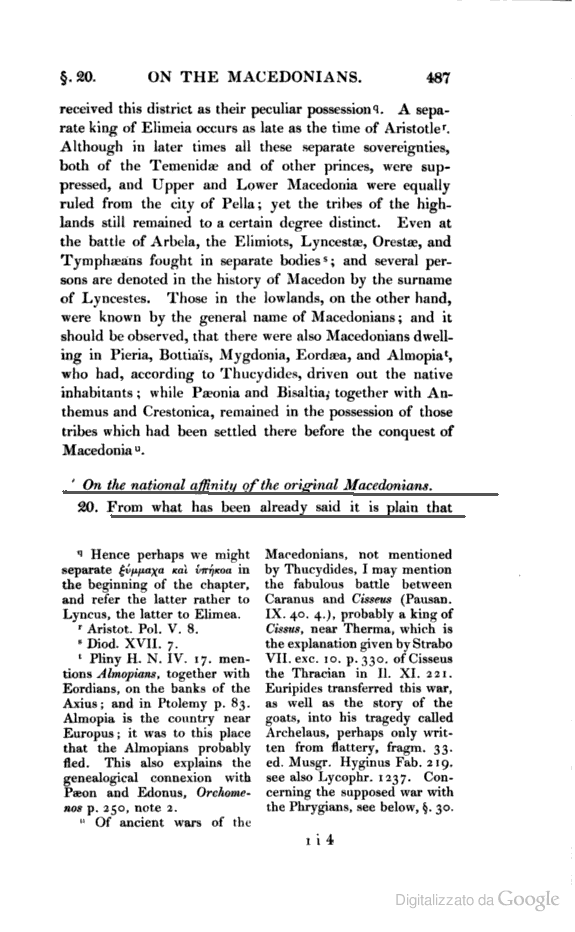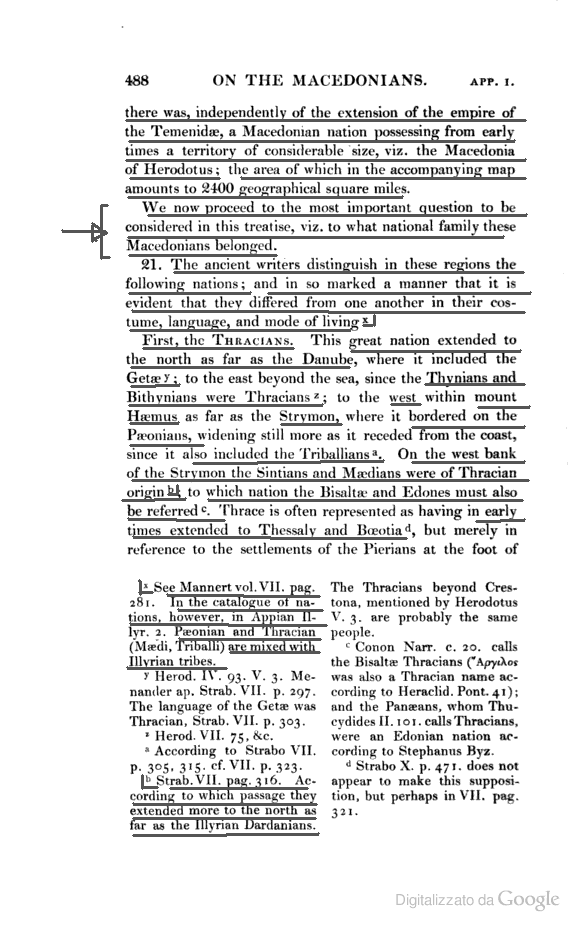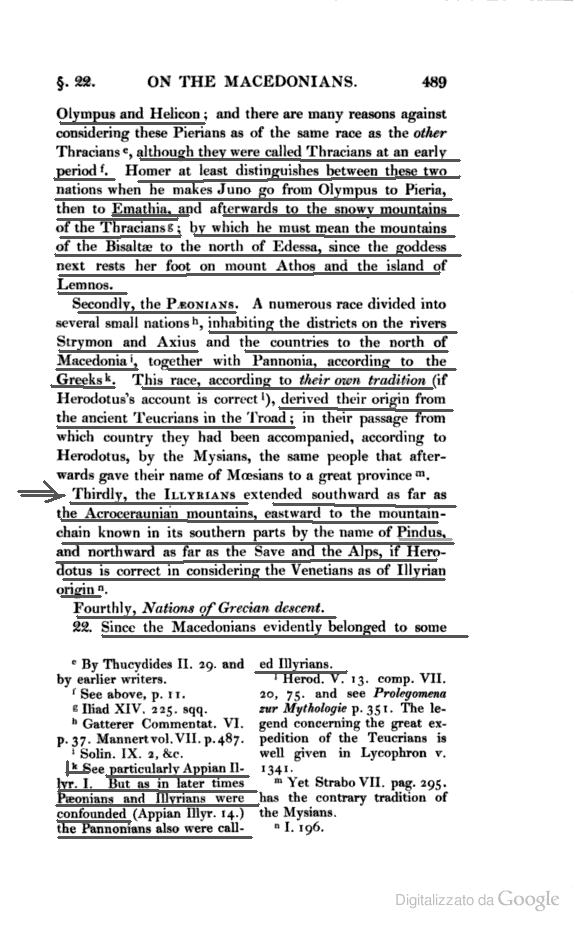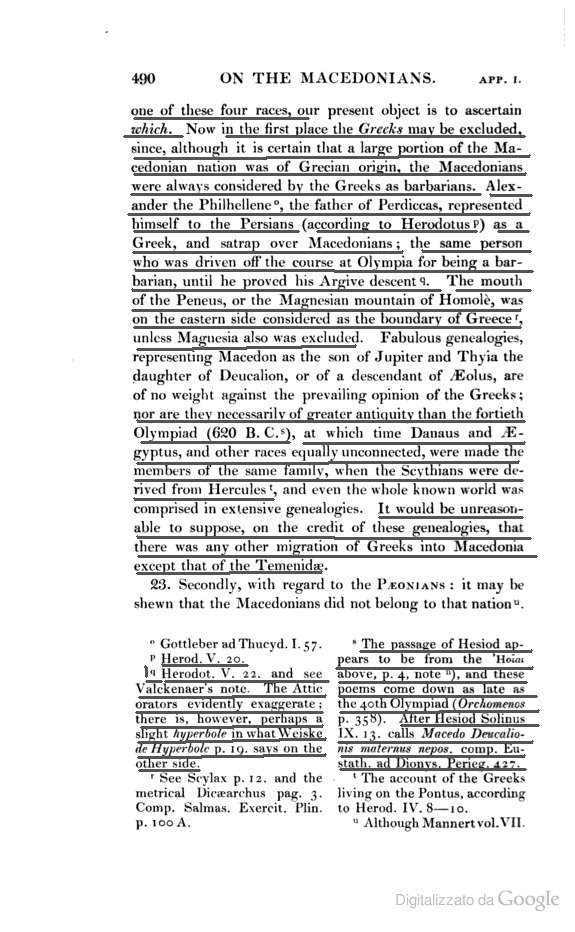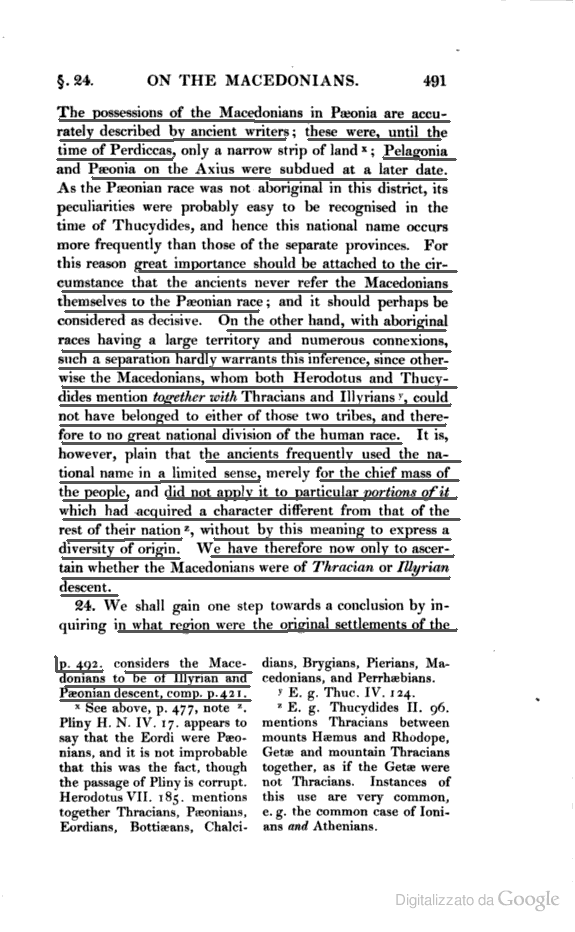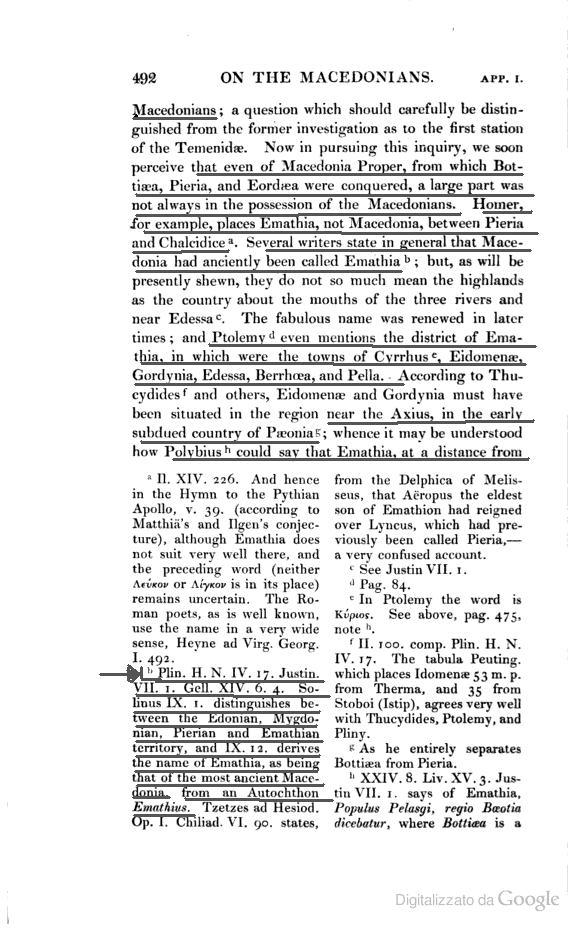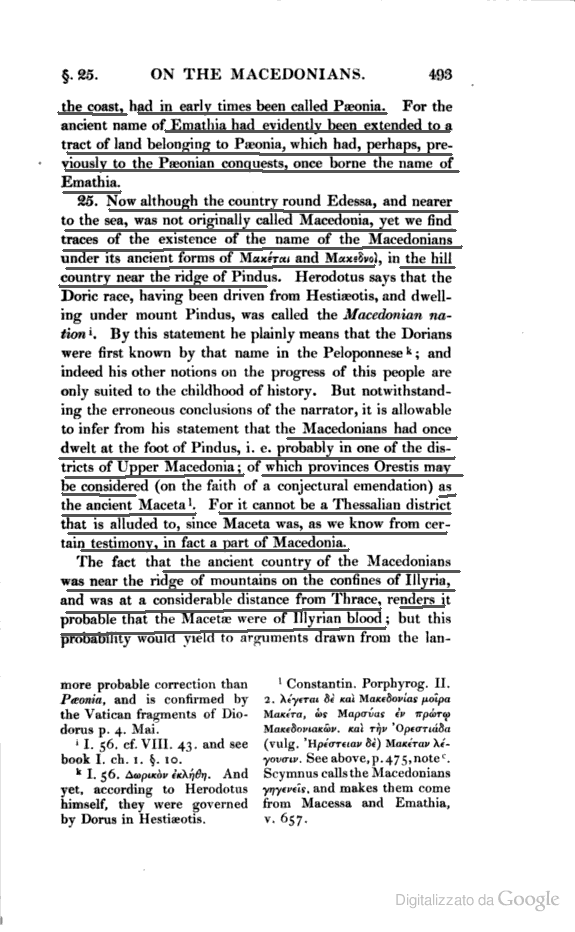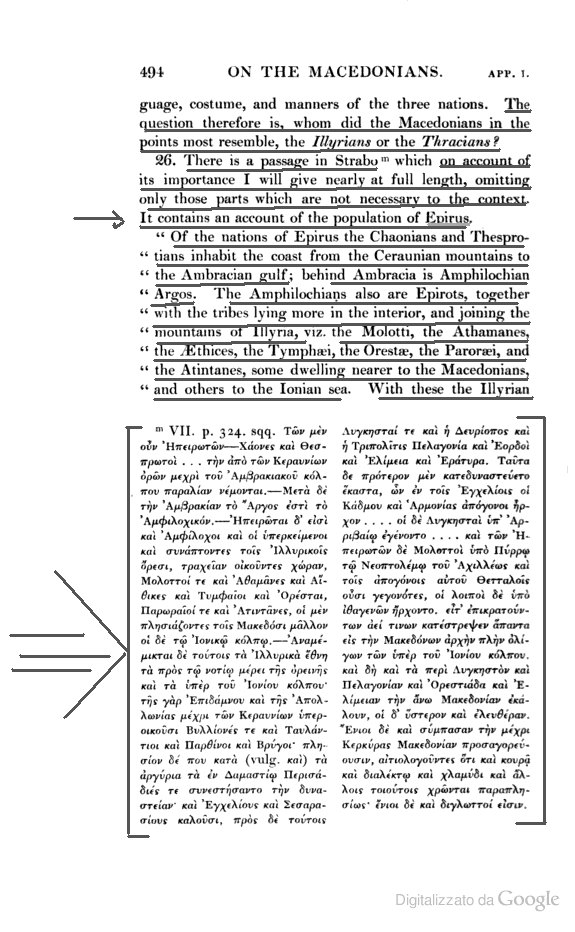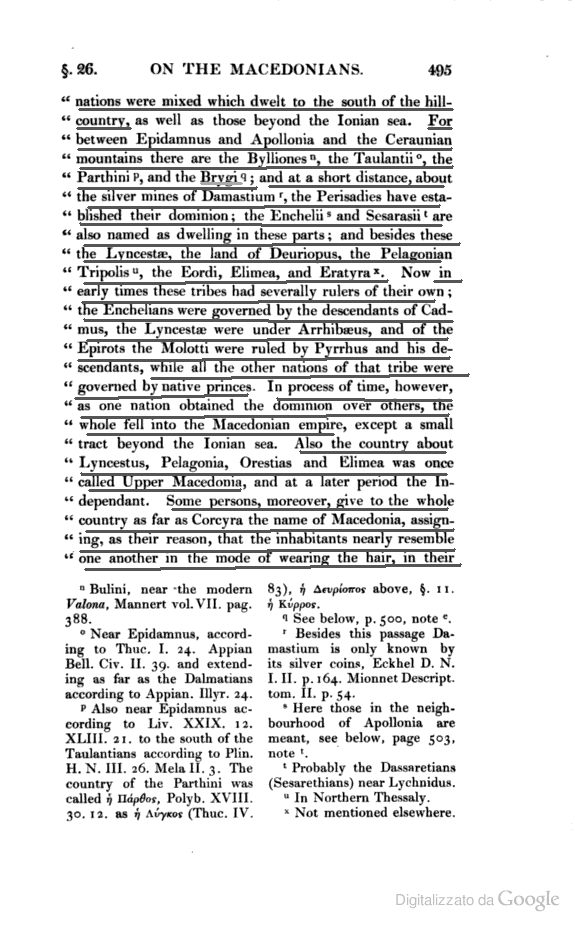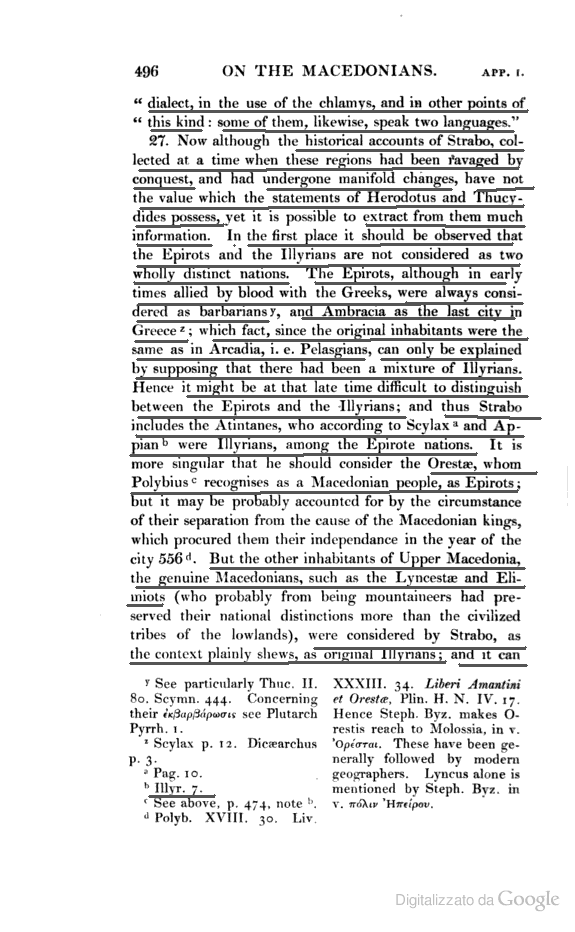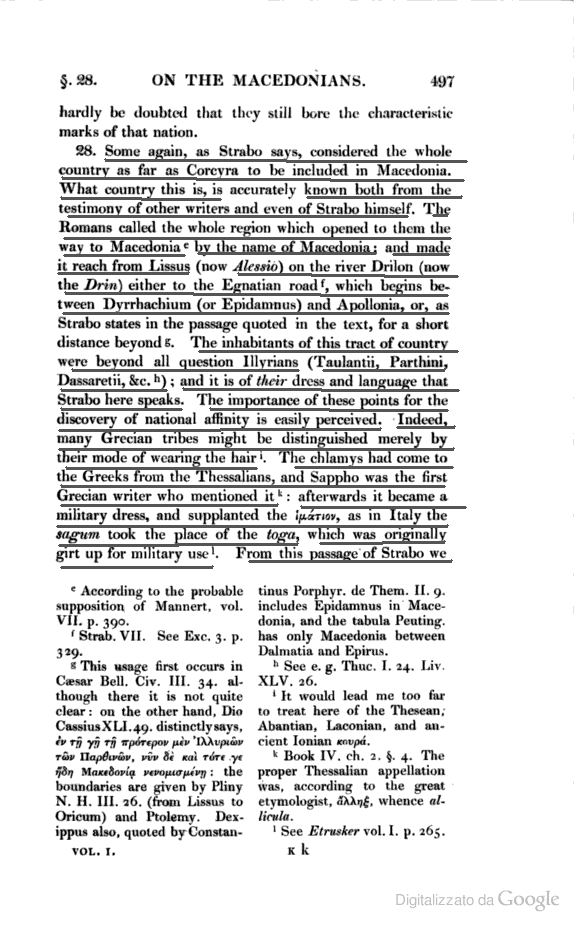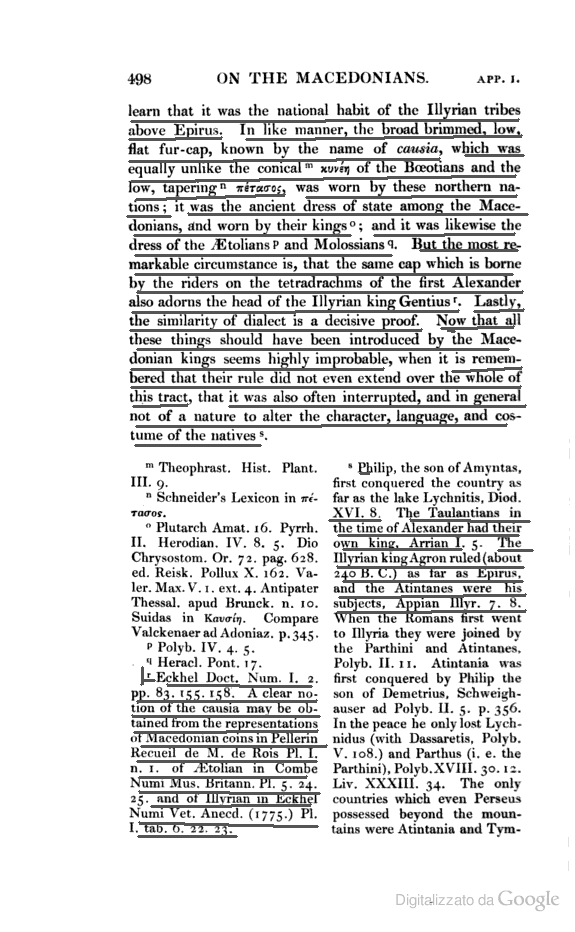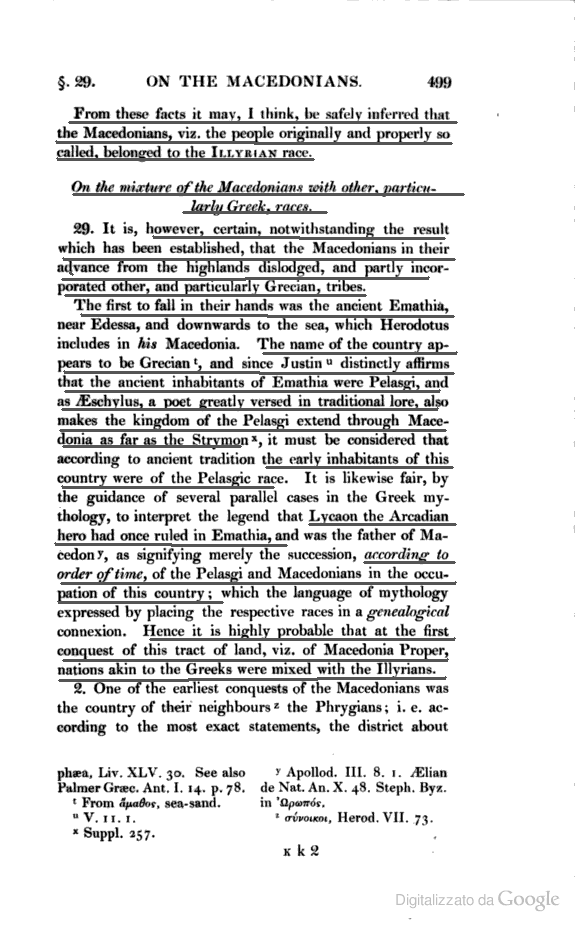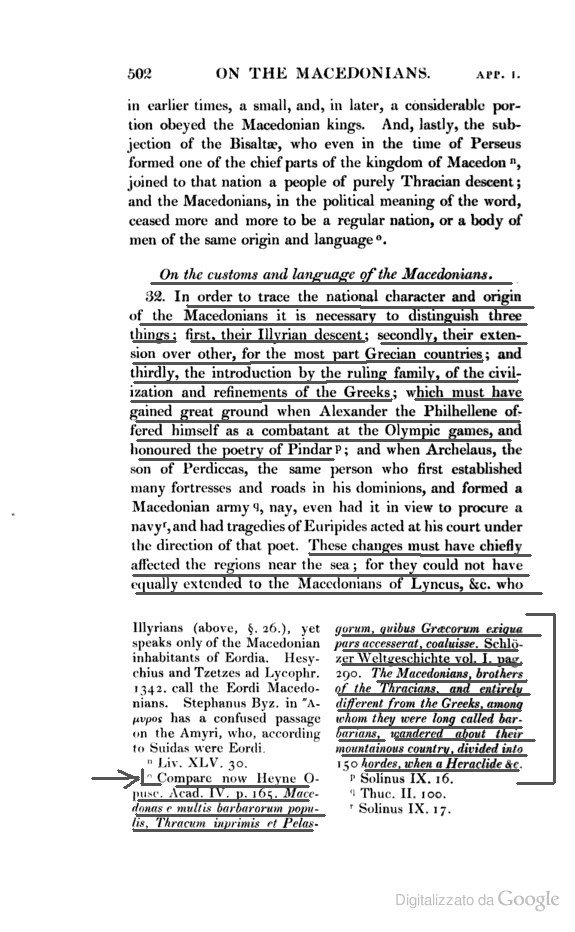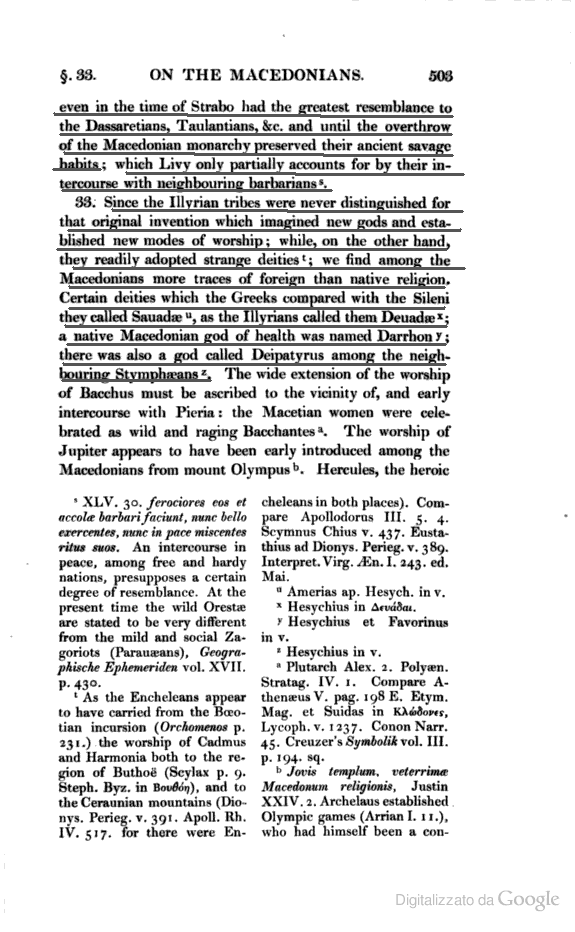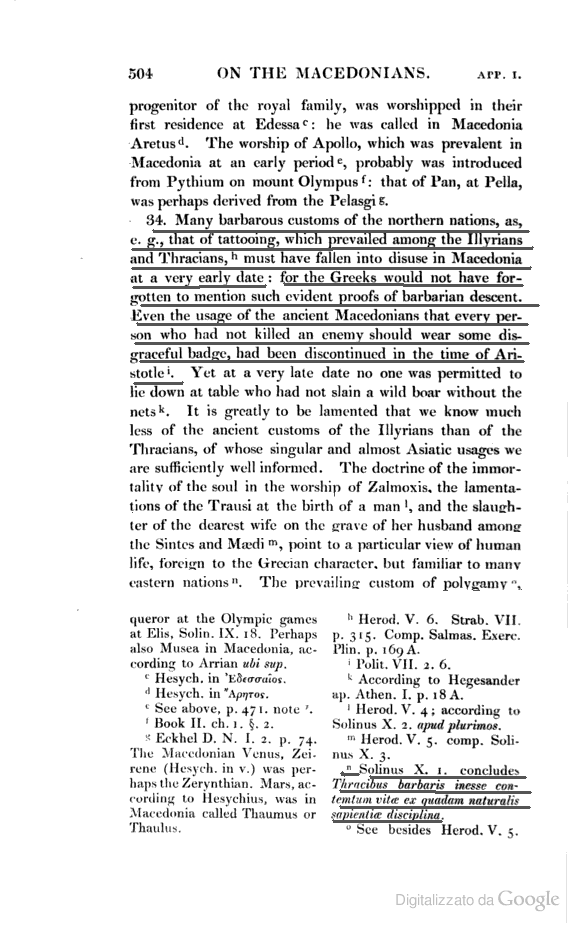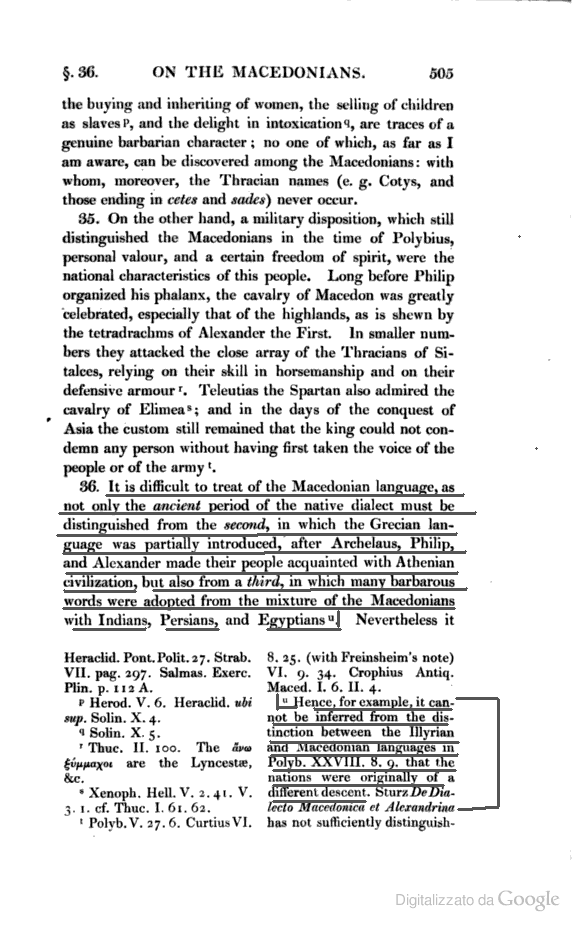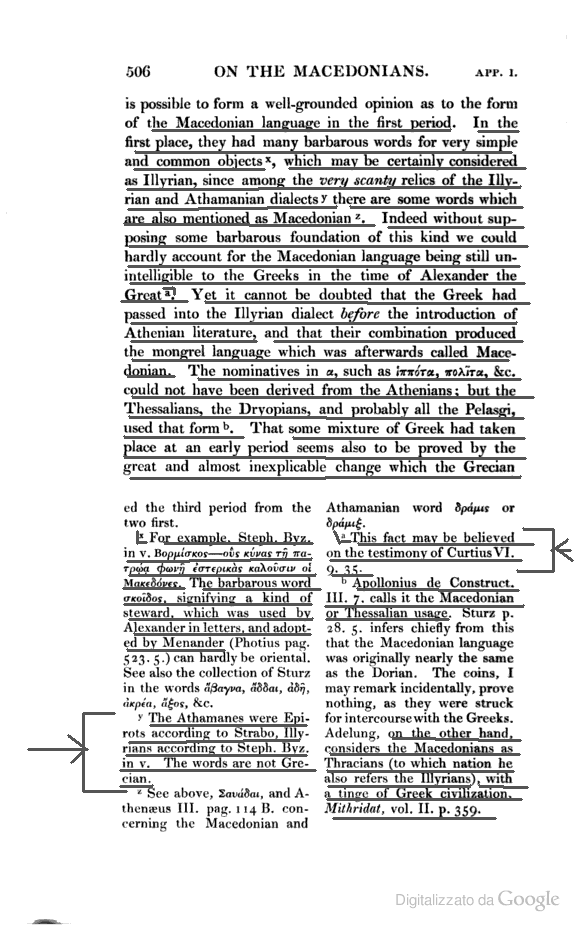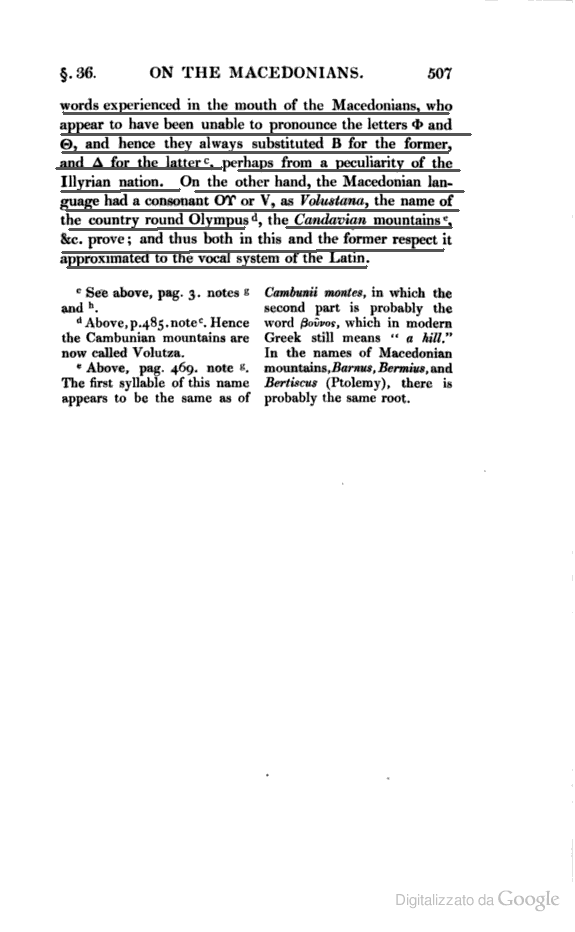THE SCOTTISH
GEOGRAPHICAL
MAGAZINE.
ALBANIA AND THE ALBANIANS IN 1898.
By the Rev. Hugh Callan, M.A.
Albania seems always to have been what it is now, the home of a sturdy, fearless race of men. It is a " land of the mountain and the Hood " ; a land of ancient customs, ancient garb, ancient feuds ; a land of clans and tribes, each embittered against the other ; a land of indi-
vidualism, Avhere the social instinct is smothered by the right and might
of each unit to do as it pleases.
Its position and configuration are such that a race once in it can defend itself against absorption by any invader. On the east it is bounded towards Macedonia and Thessaly by a line of
mountains (Scardus and Pindus)
and some large lakes (Ochrida, Presba) ; on the south by the highlands of Greece and the Gulf of Arta ; on the Avest by the boisterous Adriatic, a long line of inaccessible clifts (Chimara or Acroceraunia), and long low dangerous shores with swampy strips behind
(from Valona up to the Gulf of Drin) ; on the north by Montenegro and
Novi Bazar (with mountains going up to 8000 and 9000 feet). The interior everywhere is mountainous, with small plains and valleys between, each
usually containing a considerable town. Communication is impossible except over the high intervening passes.
If you can imagine Scotland all highlands and no lowlands, with the average height of the land 2000 feet instead of (say) 1000 feet, with mountains going up to 7000 and 8000 feet, instead of to 3000 and 4000 feet, you have an idea of Albania physically, and if further you can conceive of all Scotland being what the Highlands were in the time of Columba, you have an idea of Albania's present social condition.
Although the inhabitants do not call themselves Albanians, but Skipetars (mountaineers), and their language Ship (pron. Shkyp), there seems no doubt that Albania is the older term. The root alp seems to afford some clue to their ethnological connections. We have it in
VOL. XV. 2 B
338 SCOTTISH GEOGRAPHICAL MAGAZINE.
Western Asia in Albania (classical) of the Caucasus, and in Western Europe in Albyn, Albany (the old name for Scotland, or North-eastern Scotland), and also in Italy in the various towns called Alba, in Mons Alhanus, Laciis Alhanns, and Alba Longa, of the Komans. The latter was the most ancient town of Latium, and may have signified the "long mountain town," as much as "the long white town" — for alp may radically mean ivhite or snowi/, just as Himalaya and -X^elficov, hiems, are connected. At any rate, all the words with alp
or alh are associated with the idea of " mountain," and go back to antiquity. Some of the Pictish tribes called themselves Albanich. In modern Albania the town called Elbassan was once called Albanon, and it is in the central mountainous district, containing the purest and finest tribes. There is a village, containing a fine set of people, called Albochori {^alp and yMpiov, a place), situated 500 feet up a mountain which over- looks the remains of the Pelasgic city of Dodona, 9 hours south-west of Janina. It may have been so called '' the mountain place " in contra-distinction to Dodona in the valley.
One cannot go far in the study of origins in Albania without striking on the Pelasgic problem : " What were, and Avhat has become of, the Pelasgi 1 " That they forefathered much of ancient Greece seems certain, that they were a superior race with a distinctive civilisation may be inferred from the numerous existing architectural remains known as Pelasgic, and that they coalesced with other races as time went on seems evident from the few notices of them in historic times.
Now, it is held,
by the few educated Albanians who are competent to look into the matter, that the bulk of the Pelasgi settled in Albania, and
that the best tribes of Albania are their descendants. I share in this opinion, which local traditions go to confirm, and which would go far to explain the unique distinctiveness of the Albanian people and language. In Central Albania there are manj' villages or groups of villages
on the mountains resolutely keeping themselves apart, and the people are fine specimens of humanity, exquisite in mould, with finely chiselled features, open brow, long eyelashes, straight nose, perfect mouth, pencilled like Cupid's bow, and of noble yet quiet natural bearing.
Moreover, on inquiry of them as to who held the land " in the old old times," I was told " the PeUhhe," which is surely Pelasgi. I also find it quite a common conviction that an important people in pre-Roman times fixed most of the existing sites of places and ruins. For instance, a small church at Durazzo (called now San Giorgio, but formerly Santa Lucca),
the entrance of which is 3 feet below the present surface, and the foundations as much again, is locally believed to have first been built by the ptopulo gentile, by which term seems to be denoted something more than the Patristic sense of " all not-Christian," but rather " gentle, civilised."
A likely hypothesis regarding the Pelasgi is this : — Following the sun through Thrace and Macedonia (where as in Asia Minor they created areas), they came into North Albania, and finding the sea a bar to their farther progress west, turned southward (the mountains that way being lower than towards the north), then leaving contingents as they went,
settled about Lake Pambotis (Janina), where a new sort of country con-
ALBANIA AND THE ALBANIANS IN 1898. 339
fronted them, and thence sent various incursive waves into Greece proper. There can be no doubt that Southern Albania (especially Molossis and Thesprotis, with the great Pelasgian centre, Dodona, in their midst) was the seat of many tribes who eventually became Greeks — e.g. the Thes- salians and the Dorians. Another and a finer civilisation was developed in the towns and lowlands of the south (Greece proper). It is to a type
of an earlier world than his own, but yet by implication co-existent with his theme (the tribes of Greece and the Trojan war), that Homer refers when in //. xvi. 233, Achilles appeals to " King Zeus, Dodonean, Pelasgian, dwelling afar, guardian of wintry Dodone, and round thee are seen the Selloi, who do not wash their feet, and sleep upon the ground."
It is quite clear that the Dodona district was Pelasgian, and it seems also equally clear that the name of Hellas originated there. The Selloi are called Helloi by Pindar, and the district Hellopia by Hesiod, and Aristotle affirms that these Selloi had as neighbours a people called
" Graeci now known as Hellenes." At any rate there to this day are the vast Pelasgic ruins (resembling those elsewhere — e.g. at Mycenae) of Dodona — answering to all the scraps of information we possess about it — the ilex groves, the falling water, the jutting point of land on which the temple of the oracle stood, and the fertile land about it. There, too,
we find the strange natural phenomena of sinks or Kara^oOpa, which convey the waters of lakes (e.g., and chiefly, Janina) having no other out- let, beneath the ground to reappear elsewhere as rivers (three being still traceable, Thyamis, Cocytus, Acheron), which gave origin to the great mythological idea of Hades and the under-world. Surely the Pelasgi
must have been in a position of pre-eminence either in mental force or in numbers to have thus imprinted on the whole Grecian world their own
local religious conceptions !
Whether, however,
the Pelasgi are the true ancestors of the Albanians or not, this at least seems sure, that these must have remained unchanged
for thousands of years, as they remind one more forcibly of early Greek descriptions of life than any other existing race.
The system of guest- friendship, the grouping of the land into districts under hereditary chiefs, the dress — fustinella, tunic, sandals, and leggings, formed of strips of hide crossed — the shepherds' hairy cloaks, the huge sheep dogs, are all suggestive of ancient descent.
Having been left to themselves while all around has been changed, the Albanians have no history (strictly speaking) to boast of, but
that does
not mean that they are either a quiet or an unimportant people. Quite the reverse ; they have never been properly subdued, and are for ever in strife among themselves. Internecine feuds — one village or clan, or one division of a town against another — murder, robbery, and pillage go on
daily. A gendarmerie sergeant up in the interior told me that sometimes for days and nights together he never has off his riding- boots, so frequent are the disturbances — as often as not ending fatally — in the district demanding his attention. Often when sitting quietly in a house conversing with some local men in a town, we would suddenly be startled by the
firing of a shot, then another farther off, and others at intervals. " AVhat is it ]" — "Ah, some poor fellow finished ! That cursed blood-feud I"
340 SCOTTISH GEOGRAPHICAL MAGAZINE.
Such being their condition of life, they are far from proving amenable to Turkish rule, except that they are proud to go whenever called to fight victoriously for the Crescent. They laugh at Turkey, and where they dare not, they hate and sullenly submit.
Were they not so hope- lessly divided, they could achieve their independence in a year. It is a knowledge of this fact (coupled with admiration of the good success of British administration in Egypt) that has lately induced a number of Albanians who have thriven abroad to approach our ambassador at
Constantinople in the hope that something may be done to raise the condition of Albania, while still remaining Turkish. As they say and write, " "We distrust Austria and much more Russia ; it is the help of your great and just nation we implore. We stretch our hands across the sea."
There are three methods by which we may attempt to classify the Albanians — (1) dress; (2) religion; (3) race. So varied are their costumes that (1) dress appears a natural distinction. But there is a good deal of intermingling even in this, according to the districts. The fustinella predominates towards the south among all classes, peasants and
proprietors ; in the north it usually indicates the better-class native, proud, haughty, " the wild Albanian kirtled to the knee." The other characteristic costume is that adopted most generally by the peasants in North and Central Albania, and consists of grey homespun from head to heel, jacket and close-fitting trousers braided with black, white fez or skull-cap, or scarf going round the head and tied under the chin, ox-hide sandals (opunkas), sash and belt round the waist bristling with yataghan and pistols, and usually a long gun slung over the shoulder.
In the towns the trading classes, whether Eoman Catholic, or Greek,
or Mohammedan in religion, usually wear the fez, baggy silk trousers
tied below the knee, white socks and elastic-sided boots or coloured
gaiters and shoes, or dress in the European fashion.
The women's dress varies greatly. Some have one coarse garment,
drawn in at the waist, and go bareheaded and barefooted ; some, a tight
jacket, open in front, and thick short petticoats ; others, and more com-
monly, a simple skirt, met at the knee by a sort of thick gaiters, leather
bands round the waist, a little black shawl on the shoulders, and a richly
hued shawl or kerchief swathing the head. Most of the townswomen
dress either in the veiled Turkish style or in European style.
As to the other method, (2) religion, we might say they are mainly
Roman Catholic in north, Greek Orthodox in south, and Moham-
medan in central Albania; but, considering that out of an estimated
population of Ih millions, only half a million are Christians — the one
million being Mohammedan, at least nominally — we cannot accept this
method, even though Lord Strangford advocates it.
There remains, then, the old and only true method, (3) that of racial
or tribal difference. The Gheghes in the north are quite distinct in
appearance and manners from the Toskhs in central and part of
southern Albania — the former being dark, the latter fair in complexion.
Between them they hold what is purest and oldest in race. There are
also (to the south of the Toskh country) the Liaps and the Dzhams —
ALBANIA AND THE ALBANIANS IN 1898. 341
coarser, weaker, more civilised perhaps, mostly speaking (Romaic)
Greek.
But, on the whole — excluding some repulsive types to be met with
here and there both north and south — wherever they are and whatever
their speech, dwelling in wild eyrie-like hamlets perched on precipices
or in snug towns on fertile plains,
the Albanians give you the impression
that they are of a noble and ancient race, physically and psychologically,
both men and women, a credit in point of health, strength, and beauty
to humanity. T
he Albanian has been maligned because he has not been
known. He is fierce, reckless, re vengeful — but truthful, faithful, virtuous,
hospitable. He has the quickness of the Greek without his instability ;
the solidity of the Slav without his boorishness.
I cannot deny that it is dangerous and dreadful to travel in Albania.
But with all the outcry of danger, brigands, and of disbanded but not
disarmed soldiers going about starving and marauding, I state the fact
that I went througli it all — including some of the wildest parts not
hitherto visited — with no other weapon than my riding-switch, and
often with no other guard than my native follower, also unarmed — and
that without molestation.
It augured ill for my journey that the Turkish authorities were very
sullen and slow at Durazzo, where, moreover, I was well known from
previous visits. I found myself ominously a suspect. You see, the Russian •
consul from Scutari had been up the country recently backing the native
(Greek) Christians against the Government, and disturbances had been
frequent. The very day I arrived the Bey of Tirana had been shot dead
by a man whose privacy he was invading, and the authorities durst not
touch the murderer. It being allowed that a Turkish passport (tesJicreh)
was essential to my protection in the interior, every pretext was seized
upon to put me off. First, a change of governors {mutesarif) was going
on : the late one could not grant it, and the other one had delayed his
arrival. When he came, he pleaded illness, then his wife's death. Then
his next-in-office, when applied to, "could do no business, being in
mourning for his uncle." However, a few telegraphic messages, strongly
worded, altered the situation, and I got "orders to go everywhere, with
guards if wanted." That 's the way with the Turks : a dead wall,
nothing ! when once the right wire has been pulled, everything, more
than you want ! Then my man required his passport, but as he was
poor, and was in arrears with his taxes, he could not obtain it. By the
law he could not quit the town. So they had recourse to a legal figment.
His legal shadow, the poor Turkish debtor, remained behind in Durazzo,
while his real substance, as my servant, and pro temp, a British subject,
went with me on horseback and through Albania, was finally smuggled
across from Previza to Greece, thence rid Corfu returned to rejoin his
wife and family and legal shadow at Durazzo.
While waiting I explored the long, isolated (separated from the main-
land by a Avide salt swamp, on which the Government carries on salt-
panning) ridge, on the south end of which Durazzo lies. Its height
averages from 300 feet to GOO, length about G miles, soil argillaceous,
beautiful clay of many tints, from dull grey to bright orange. The sea
342 SCOTTISH GKOGRAPHICAL MAGAZINK.
lias encroached, revealing traces of Roman brick-kilns and terra-cotta
remains in layers several yai'ds below the present surface. Solid walls
of very fine seaweed, from 5 feet to 15 feet high, are piled all along the
shore. The northern part contains quartz on the top and vast con-
glomerate heaps below. That the whole seaward slope was once a Cam-
pagna lioinana, the thick copses, where now foxes, hares, and weasels
make their dens, crowded with fruit-trees Jind plants, all degenerated to
their wild state (vines, figs, apples, asparagus, phlox, sweet-william, and
many such, especially about a beautiful hollow called Calmi, with an
immense fig-tree in the midst), testify at this day.
Starting from Durazzo eastward, our path the first day went over a
series of low sandy hills, with long stretches of reedy marsh between,
then along the bed of the river Arsen, and up on to a fertile plain covered
with flocks, through deep woods of olives and abeles, up to 500 feet.
Judged by the various hamlets and khans and by the red-tiled
houses peering out amid the woods, this district seems prosperous. Half
of the peculiar picturesqueness of Albanian scenery is dive to the deep
yellow or brown of the soil, contrasting with the light green of vegeta-
tion. We came out on to a plain at right-angles to our course, running
from Tirana north-west to the Drin Gulf, with the town of Kroia on the
east, 2000 feet up a range 5000 feet high — an impressive sight, with its
walls and palace up on the precipices. We passed a row of tall poplars,
at least 500 yards long, and found ourselves among the planes and
cypresses and minarets of Tirana, lying at the foot of Mount Daiti (5000
feet). A city of waters, runlets along the middle of the cobble-paved
streets, with bridges crossing ; a city of houses amid gardens, of mosques
and graveyards, of enclosures containing sweet streams and cypresses
(80 to 100 feet), and plane-trees (6 to 10 yards in girth); of wonderful
costumes of Gheghes men and women coming and going and pressing in
the narroAV slippery lanes ; a city of great markets, where hundreds and
thousands of horses and donkeys and oxen crowd all the oj^en places,
and fruits of all kinds, melons, bamyas, patiljans, pepper-pods, onions,
and small ware of all sorts, tins and pots, mirrors, combs, soap-cakes, and
trinkets are spread out on carpets for sale ; while over all the glorious
shapes of clouds, arrested by the proximity of a mighty mountain range,
lie in deep rosy beds filled with the sun ; the cicalas in countless multi-
tudes whir their monotones in every bush and tree, and the cuckoos call
from grove to grove — such a i)lace is Tirana !
To get to the next city, Elbassan, we had to cross perhaps the
stifFest pass in Albania. First, we cross a low range (500 to 600 feet),
with heights above, on one of which (to the west), around a castle, there
lives what is said to be the purest and oldest tribe in Albania. Then
we rejoin the Arsen in a deep ravine, Avith the cliffs rising abrupt on
either side. Here we crossed eight times at least within half a mile,
wading or swimming our horses. A sort of path exists, up and down
the banks, sometimes rudely paved, always deep in mud, often as steep
as a house roof. The rocks in the river bed are whinstone, in the
ravines yellow sandstone, while the prevailing character of the moun-
tains east and west, dark red in colour, seems ferruginous. The few
ALBANIA AND THE ALBANIANS IN 1898. 343
villages are so suited to the soil, and so buried among woods, that one
can hardly detect them. The sweet sandy lanes are gay Avith heaths,
thistles, campions, geraniums, nipplewort, calamint. At 950 feet (temp.
65°) there is a khan called Cafkhrab, under a village called Skuteh.
Beyond this we leave the valley of the Arsen (which here trends east-
ward) and ascend the Khrab mountains. The path twists up among
huge jutting blocks of rock and prickly Palmrus bushes (where one is
bruised and scratched all over) up across a vast bare sloping wall of
shale and whin (where a thunderstorm burst, making the horses start
and risk a fall down the unbroken slope for 500 feet, and as much again
sheer below that). At 2000 feet Ave pass a guardhouse (two soldiers)
and begin at once to descend, abruptly, leading the horses. We come
to a melancholy Avood, Avith bleached trunks of trees, a mossy fountain,
a grave or tAvo of murdered travellers ; then up and doAvn again over
three eminences 1 200 feet high, among the glorious red soil and the
shining patches of quartz by giddy slippery paths into the valley of the
Zaranika. DoAvn past streams and dams and mills, and men and
women shepherding, into lanes bordered Avith tamarisks and wild vines,
and on over the broken causeAvay {selciatci) through olive groves and
grassy meads, and out on to the Avide plain of the Skumbi, A\'ith vast
Tomorhit and its triple crests toAvering away to the south, a glorious
purple Aasion.
Elbassan is very Mohammedan — population 12,000, very few being
Christians. But if my host, Hassan Dommi Effendi, is typical, no Chris-
tian can have much to complain of. The humanity of the Turkish
system is Avell seen in its tolerance of the lower creatures. DaAvs and
jays wheel about the old clock-tower and the tin-plated minarets in
flocks ; turtle-doves sit and coo on the branches of the grand old
mediaeval cypress-trees. As Hassan said, "The poor here are oppressed,
but it is bad men, bad Turks, who only wish to enrich themselves, do
the big, and go back to Constantinople, who are to blame, not our
religion, nor our good Sultan (Inshallah) ! If Ave had only schools here,
the people are naturally so bright and intelligent that they Avould soon
surpass all their neighbours." It is the case that there are no national
schools in Albania, very feAV of any kind, and only in the bigger places a
Roman Catholic or Greek Orthodox one, to which, of course, Moham-
medan children cannot go. Elbassan is very picturesque in its streets
and situation, and very rich in types of physiognomy. The finest tribes
make this their market town. Any day you can see crowds of hill
people trooping in and out, their splendid physique and serious
demeanour contrasting AA-ith their appearance of extreme poverty. Tall,
lithe, big-boned, strong-nosed, high-cheeked men and women, with large
liquid dark eyes, long eyelashes, dark hair, are the rule. Some rude
repulsive types are noticeable, but no Aveak faces. Some Avomen have
absolutely carrot-red hair — of the loAvest class, evidently, for their one
garment is a rough brown cloak dreadfully tattered and patched. Here,
as mostly all over Albania, there is not much close veiling. It is
boasted that, when on a festival the people gather in thousands in the
large cypress-grove, no such assemblage of fine men and lovely Avomen
344 SCOTTISH GEOGRAPHICAL MAGAZINE.
can be seen elsewhere. As to the religion of the hill people, it seems
doubtful if they are really Mohammedan. Most of them are Turks to
the Turks and Christians to the Christians, nominally Mohammedan,
while cherishing for centuries a sort of vague hybrid Christianity —
perhaps a relic of the Albanenses. Such is the view of the scholarly old
Bishop of Durazzo (Greek Church), who lives here.
We were a large caravan when we faced the stage between Elbassan
and Ochrida — one of the worst for desolateness, steepness, and brigands.
Having heard that a Frank was going, quite a number of travellers had
waited to join us, for greater security. There was the old weather-
beaten rugged suvari (Turkish guard), the retfurino, or horse-hirer, two
Albanians bound for Asia Minor, a Greco-Jew bearing trinkets and stuft'
fabled to be worth £200, a quiet pensive young Turk, and several others.
From the bed of the river Skumbi (anc. Genusus, town Scampae) we
climbed by steep tortuous paths up a hill 1000 feet, then one 1700, then,
by fearful sweeping bends around precipices, up to 2300 feet — and so on
from height to hollow, from ridge to river, up and down for two and a
half days, the last climb taking us up to 4000 feet, and showing us the
glorious lake Ochrida, with a Avorld of mountain all around. In the
deep valley of the Skumbi the scenery is wild and rugged, and whatever
cultivation is seen, is only on small plateaux at some height above the
river-bed. On the north the mountains slope up and away in broad
expanses of deep red varying to yellow-brown earth, then belts of trees,
then bare round heights much scarred, resembling Herzegovina, and
distinctly of Karst formation. We kept the south side. Sometimes for
hours we would toil in the great heat — the thermometer never fell below
70° — under a huge wall of limestone tov/ering 1000 to 1500 feet up,
with torrents rushing and roaring down and carving out fearful chasms,
around which we had to clamber with precarious footing, not reassured
by skeletons of horses lying bleaching in the sun or pecked at by vultures
below. Sometimes the eye would be dazzled by vast piles of red
porphyry and glittering veins of quartz. Sometimes the whole side of a
mountain would face you, black, a field of anthracite or other carbona-
ceous rock.
On a plain bit of road as we approached Khukuz khan (and
village on the cliffs above it), we were in straggling order, when
suddenly at a bend I caught sight of a group of men rising up as if
surprised. The old suvari cried chahook (hurry up !). On came the big
fellows, with skull-cap, jacket, and fustinella, and rifle slung at the back,
and breast bristling with cartridges — one after the other, twelve of them,
towards us. Our file and theirs met and were passing, when number
three of them as he passed brought the barrel of his rifle right against
my side. However, quietly and smilingly lifting it aside with my
riding-switch, I declined the quarrel, and we all passed on in silence.
"They're all notorious villains and murderers," said the suvari, "but
they '11 not venture this time, as they didn't expect the English efFendi."
In the khan (where of course the twilight hour was spent in listening
to Albanian singing, mainly recitative; theme, love and war), we all slept
in one room on rush mats. New arrivals lay down amongst us until
MOUNTAINEERS OF SAL A..
MIRDITI WOMEN FRuM THE KROIA MOUNTAINS.
LAKE OCHRIDA AND THE MONASTERY OF ST. JOHN THE DIVINE.
JANINA, WITH ALl's FORTRESS AND ISLAND IN THE BACKGROUND.
ALBANIA AND THE ALBANIANS IN 1898. 345
there was no more decent space. The cold was intense (at night). The
iieas were in legions. The cocks began to crow two hours before dawn,
and kept it up till dawn, so that the whole country from the riverside to
the mountain crests seemed peopled with chanticleers — indicating that
those deep side ravines and hollow nooks were not so innocent of
inhabitants as appeared to the passing traveller.
Over the last ridge, we emerge at the north-west corner of the lake
basin, and see what a vast country we are in — a ring of mountains,
dominated on the north-west and north-east by several mighty peaks
6000 feet to 7000 feet (of Shkar, anc. Scardus) ; mighty gorges filled in
with lower swelling hills sending down their alluvial debris to the shore;
the deep-blue lake itself in the midst, with a broad belt of verdure for
its margin. The many people we meet now on the fine road (Via Egnatia,
re-made), are smaller, darker, less frank, speaking Bulgarian, wearing not
the fez or fustinella, but the Bulgarian Imlpak and cloak, or old soldiers'
clothes. At Struga there seems to be a good deal of trade, especially in
fish. The shore-line is broken with huge apparatus for fishing. Myriads
of fowl blacken the water far out into the lake. All the way to Ochrida
we met a continual stream of traffic — peasants, Albanians, and Greek
poppas with their families, Turkish officials with retinues. At this great
altitude (2100 feet, lake level), the flora is astonishing — vines, haricots,
melons, pumpkins, gourds in the fields; wild vines, hollyhocks, valerians,
spurreys, pearlworts, dianthus by the road.
Ochrida, built on two hills ending in cliflfs at the lake, beneath the
swelling bosoms of the upper mountains, on the margin of the beautiful
blue lake, is one of the most charming places on earth. Here Christians
and Mohammedans are about equal (population 12,000), and there is
neither discontent nor oppression. Flowers abound in windows, gardens,
yards, and walls, declaring (said a citizen) the presence of Christ, The
swallows and cuckoos are here (they say) all the year round, and the
storks build their nests on the tops of the minarets.
In the great vaulted gate of the old town (beneath the acropolis or
kastroii) are many lettered stones, mostly built into the ten-feet-thick
walls. Some are pieces of entablature ; others slabs. One is of a dark
ruby colour, bearing Greek lettering in memory of some " Cleanthus,
son of Ptolemy." Another (6 feet X 3 feet) bearing mixed Greek and
Roman characters, the first word being AVPIA — which may be Achrida
— is probably a milestone on the Via Egnatia. The bare massive walls
alone remain of the early church of St. Clement (burnt by the Turks in
the fifteenth century). In the one which replaced it (Byzantine) many
relics lie about — pieces of columns and capitals inscribed — probably of
the fifth and sixth centuries. In a side chapel there is a statue of Pope
Clement of Home sent by him along with a Madonna-and-child painting
to his namesake St. Clement, Greek bishop of Ochrida. Around the
exterior of St. Sophia (now a mosque), said to have been built by
Justinian (sixth century), there is a Greek inscription Avhich seems to
refer to the teaching of the scriptures among the Moesians {rov deoypacjiov
vofiov eKSiSdcTKei edvrj ra \]oLcro)v).
Ochrida lake (anc. Lijchnitis, possibly so called from its wonderful
346 SCOTTISH aEOGRAPHIOAL MAGAZINE.
transparency, which enables one to see the fishes disporting 20 yards
below) is the lari'est of all Balkan waters, and is one of the most beauti-
ful in Europe. Around it are some dozen happy villages in the alluvial
hollows, besides Struga, Ochrida at the north end, and Pogradei; and
8. Naoum monastery at the south end. The western side is in Albania,
and consists of a succession of deeply wooded hills under a higher range,
with cultivated alluvial slopes between. The eastern side is in Mace-
donia, and is almost precipitous to the shore (the Galicica range, G700
feet). The river Drin, issuing at the south-east end behind S. Naoum,
flowing in its own course through the lake, and having its exit at Struga,
is the boundary of these provinces. M. Eeclus (who often has Jules
Verne's so happy knack of truly describing what he has never seen) is
quite " out " when he supposes that the lake had once its exit on the
south by lake Malik and the river Devol ; for the south end is a wall of
mountain (from 500 to 1000 feet above the lake), and Malik is at least
150 feet higher in level. It is more than probable that the Drin, so
copious a stream at its issue from the mountains, carries off subter-
raneously some of the waters of Lake Presba (to the east of Ochrida).
The only boats in use on Ochrida are remarkable, and perhaps of the
oldest type extant — flat-bottomed, of some dozen pieces altogether, 1 8 to
20 feet long, narrow, bow rising like an ancient galley, broadening
to the stern, a heavy log on each side outside along the body, four rowers
on the port side (three in the bows and one at stern), and the steersman
with oar at the starboard stern.
The sun sets over Albania, but Macedonia still seems all on fire. To
us on the lake the water for half a mile from the beach is black with
waterfowl fishing ; the hills above Pogradec^ are covered with dark woods,
all good chestnut-trees ; the yellow mountain slopes above are lined with
long strings of goats wending their way home. The people about here
are mainly Toskhs, and wear the fustinella; but as the local names (e.g.
Pogradec, from pod and grad = lower town) and the furred jackets and
cloaks indicate, it is not long since the Bulgarian element predomi-
nated. They have an ill name, which the first news we got, that two
passengers by the post {menzil) had just been killed, bore out. Their
chieftain, however (Uzcheref Bey), assured me there was nothing to fear.
The great monastery of St. Naoum {a'yio<; Naowyu,) stands (opposite
Pogradec) on a jutting rocky strip of land close to the lake ; is quad-
rangular, with white walls, red-tiled roofs, and Avith numerous outhouses,
granaries, and workshops clustering about it. The rocks are limestone,
much fissured, and out of them copious streams of clear icy water fall
into the lake. The whole district around, including a village and the
mountain, is tributary to the monastery. Besides the ?;7ou/iei/o9
(superior), three monks and a schoolmaster, there are seventy inmates.
There are cells for monks (formerly thirty), guest-rooms, a large veranda
with mats for Mohammedans, stables, kitchen, slaughter-house, school,
and a large residence for the superior and better-class guests. The
church in the courtyard is a thousand years old, Byzantine, contains grey
marble columns, many Cyrillic and Greek inscriptions, and the tomb of
S. Naoum, who came hither from Asia Minor in A.D. 800.
ALBANIA AND THE ALBANIANS IN 1898. 347
From this to Korica is an uiivisited district. It is an undulating
hill country as far as the end of Lake Malik, average height 3000 feet,
with several considerable villages dotted over it — Cirava, Causli, Malikc,
Sofiani, Kastifalik, in order going south. Malikc is at the outlet of the
lake on the west, and it seems that is the name the river goes by too,
being called Devol only much farther west. The plain with the lake
in its midst runs on to the great Korica plain, striking it at an angle of
about 25°. At the north-east the Galicica mountains drop abruptly on
to a lower range which shuts out Lake Presba, while beyond and to
the south rise the massive spurs of Pindus. The north end of the lake
is filled up with gigantic reeds, leaving only a long line of water in the
middle. The shores are choked with these, the nearest being 10 feet
tall and those farther out 20 to 25 feet, with huge bulrush heads. Long
lines of flame at points where they are being burned are visible even
in the sun, 40 to 60 feet in the air. We pass plenty of good sandstone,
fine hard slate, much trap-rock. The altitude of the plain is between
2400 and 2450 feet. The thermometer rose from 70° through the fore-
noon to 95" at noon. The flora consists of mighty water-lilies, spreading
their cups among the rushes, tall red and yellow thistles (4 to 10
feet), enormous umbellifer^e, hyperacete, hollyhocks, valerians, blue and
red geraniums, toad-flax, nipplewort, gallium, dianthus, poppies, sorrel,
cress, phlox, rest-harrow. There is much cultivation — maize, pumpkins,
melons, pepper.
Grandly placed is Korica town under the Morava mountains on the
east side of the plain, which area long line of serrated, bare, reddish, or
copper-coloured hills — trappean — average height 5500 feet. Korica is
very lively, a great market centre. All around it are fields, vineyards,
vegetables, flowers, groves. The population is 19,000, of whom 12,000
are Greek Orthodox, and 200 or 300 Eoman Catholic. They are dark
in hair and complexion, and wear fez and fustinella. They call them-
selves mostly Greeks ; but they are simply Albanians, largely mixed
with Bulgarian blood. The true Albanian among them is always
noticeable — by his head, broad at front, with knobs, and towering to
the crown, flat behind, denoting intelligence with little reflection, firm-
ness with much egotism. The mountain villagers about here are said
to be very fanatical and treacherous. I climbed to the nearest village
called Boria {ifiiropLal), where there is a Byzantine church of date 1390,
the interior of which is covered with Cyrillic writing of date 1500, I
climbed farther up to a peak 4300 feet, where are ruins called rutet (a
word always applied to a hill town or castle ; cp. city, citta, cite, civitas).
They seem Byzantine — not Venetian or Roman as supposed — and are
composed of the whinstone of the locality cemented with beautiful white
lime. The Morava range is very rich also in granite and in coal, and
possibly copper. Across the plain, among the hills, there is a good
copper-field, and near a village called Debarza above Ochrida there is
another ; the specimens from both show excellent copper. Concessions
to work have been granted to a local family of the name of Moscha, and
French and German engineers will be on the spot this year.
From Korica to Janina (pron, Yanina), four days' ride, is a wonderful
348 SCOITISH GEOGRAPHICAL MAGAZINE.
but terrible journey. The district has the worst name for robbers in all
Albania. Roughly, it consists of a succession of ravines winding up and
down among lofty mountains and tablelands. As far as a place called
Eimizi (where are the sources of the Osum, farther west termed the
Beratini, which jjresently joined to the Devol, becomes the Semeni, and
falls into the Adriatic above Valona) there is no cultivation, only bare
rocks (lime, whin, carbonaceous) sparsely clad with junipers — average
altitude 4000 feet. Vast stretches of chrome slopes under the Grammes
mountains on the east and the Skrapari on the west ; many villages with
minarets ; a long, wide plain completely honeycombed with deep clayey
gorges ; a very Turkish, tumble-down, hoary-looking place called Hersek
(3380 feet, temperature 69° evening), constitute the region called
Colonia. Thence we pass into a very white limestone district containing
some very deep fantastic ravines, with small Christian villages in them
embowered in walnut groves and gardens. At the edge of one such you
look down, from a height of 3500 feet, at least 1000 feet sheer below on
a happy valley filled with flocks, village, mill, bridge, torrent, while all
around rise pinnacled, castellated, or pyramidal heights of various hues,
and towards the east two huge pyramids sending down their debris, all
covered with woods and fields and nestling white houses. Here the tints
of the soil often vary within a dozen yards — white, yellow, orange, violet,
red, great masses of sulphurous stuff. The road proceeds by fearful
zigzags from one valley to another. Then we descend into a blacker
region — one of tremendous ranges — basaltic, trappean.
At the foot of one of those masses — one mile long and 2000 feet at
least sheer up, a spur of the vast Ximerecka (7000 feet) towards the
west — lies the town of Liaskovik, but at the head of a great heaving
basin filled with miles on miles of lower hills, valleys, and rivers,
stretching aAvay south till blocked 80 miles away by the mountains of
Thessaly. It would be hard to conceive a grander site. The town
has a grey, decayed look, but is lively enough. Strangers seem to be
feared, and it is said that there is a good deal of exaction on the part of
oflicials. Beggars abound ; one of them I saw sitting in manacles cursing
and joking by turns. It is a real bit of Turkey : the very boys come up
and demand your reason for going about ; ladies close-veiled, and with
parasol, are out taking an airing, and baby in cradle comes behind on
the black slave's back ; round the only fountain all day and evening
there is a continual trafiic and babel — dark Zingari servants and w^omen,
young and old, in scores crowd round the one slender source with
barrels and pitchers, and the horses let loose after work canter up
neighing and whinnying, and force their way to the spout.
Hence we descend into the bed of the Sarantaporos (forty fords) and
the Vojusa, and clamber along precipices and then over a beautiful pass
full of streams and woods to the plain whereon the two rivers meet —
Yojusa and Charadra. To the north nestles the town of Konica under
cliffs and above green fields and the broad white expanse of river bed,
while right overhead to the east are some of the giants of Pindus —
Papingo, Lazari, Samarina, stupendous masses with one or two conical
peaks. For half a day we wander up and down in the vast forest that
ALBANIA AND THE ALBANIANS IN 1898. 349
clothes all the mountain to the south, where the solitude is oppressive,
unbroken except by the flutter of jays and the screeching of hoopoes.
The trees are chestnut, walnut, oak, bsech, locust, I'aliurti>', tamarisk. At
about 2300 feet we begin again to descend, and come on to a plain
(1300 feet, temperature 69^ evening) covered ■with flocks and herds,
skirted by oak woods, smelling sweet with clove and lavender, and
surrounded by crenellated ridges, over one of which a road diverges
towards Santa Quaranta. Here in the huge khan of Kalibakia we find
a distinct approach towards Greek manners, and hence southward the
same change in physiognomy, scenery, houses, cleanliness is noticeable.
Up over several long hilly defiles for many hours, then down on to the
plain at the end of which Janina lies, visible ten miles away. The
plain at the north is 1 J miles broad, but widens a little towards Janina,
and there is also a slight rise from 1600 feet to 1650 feet. This fact
is important in considering the drainage of the lake. There is a great
deal of water at the north end, miles of gigantic reeds (Lake Lapsista 1),
and a long stone bridge (dilapidated) crossing it. Janina lies in the
angle on the west, where the plain turns from north-west and south-east
to north and south. The lake has two basins (of almost equal dimen-
sions), one in either direction. Its water is (usually) dirty grey and
strong-smelling, both colour and odour being due to insufficient outlet
and much evaporation. The sinks (Kara^odpa) are the only outlets
for all the water in the long depression of close on 25 miles, which is
shut completely in by the Metzikeli range, running north-north-west by
south-south-east, the ridge of Drysco, behind to the east, and the peak
of Peristeri to the south.
On the rocky promontory jutting into the lake are the fortress and
palace of AH (Tepelini) Pasha, now barracks and hospital and common
houses. On the summit beside a mosque and minaret, and beside the
tomb of St. John (a Christian martyred by the Turks here, whence
Joannina, John's town) All's headless body lies in a gilded tomb beneath
a solitary cypress-tree. A few hundred yards across the water is the
fatal island where Basilike (his favourite) betrayed him, and his own
soldiers shot him. The island is of limestone, contains several vast
caverns (some always filled with water), inside one of which the old
monastery and church of St. Panteleemon are built. It was here in a
room on the second story he met his end : beside the divan on the
floor are five bullet holes. Only one old woman, a nun and rheumatic,
is now in the place.
Janina is very fine, very Greek, there being three Christians for
every Mussulman. The garrison numbers about 650 men, but 4000
nizaiii men could be brought in in a day or two's notice from the
villages.
South-west over the hills lies the Pelasgic ruined city of Dodona,
about nine hours' ride. You go over the plain to Rapsista village, then
up a ridge 1750 feet; then another, 2100 feet; then (past vineyards!)
up to 2650 feet; then down into a long valley running north-north-
west by south-south-east past long fences of ancient stones, through
meadows, maize fields, streams, bosky patches around cottages — walnuts,
350 SCOTTISH GEOGRAPHICAL MAGAZINE.
limes, poplars (abeles), but mostly the ilex oak. This famous Thres-
protian (or Molossian) valley is 2 miles broad by 15 to 20 miles
long, average altitude 20U feet, each end being closed in with hills. On
a jutting point of land (which is doubtless the promontory Hesiod
mentions) are the ruins. The ilex-trees are everywhere around it,
especially on the north ; and here may have been the mysterious oracular
wood, the rustling groves of Dodona, or it may have been aci'oss the
valley and up the other side on the south around an abundant spring of
water at Alhochor'i, where the trees (all ilex) are very big and old.
There is no lack of falling water (another oracular means of Dodona),
for the steep sides of Tomarochora (4500 feet) are scarred profoundly,
and great torrent beds extend right out from it over to the temple site.
The oldest building is behind the amphitheatre — rows and lanes of
rough Cyclopean stones, mostly one yard square. The stones of the
piers and amphitheatre (which faces due east) measure mostly 5x3x2
feet, but at the top they are 8x3x2 feet. The natives say that there
are no treasures or trinkets to be found now since Karapanos carted
away his " three wagon-loads " to Athens. See his Dodone et ses ruines.
From Janina a grand road (made by AH Pasha) runs to Arta and
Previza, through some of the scenes of the late war. Down, down, we
go, skirting the dread Suliote hills — round precipice after precipice,
under great hanging sloping masses, moraines, caverns, natural tunnels
— over several most romantic passes with bluffs overhanging 800 to
1000 feet — down along the Louro (anc. Oropus) river in ever increasing
richness and variety of scenery and indications of pleasant human life.
"We pass much traffic also on horses and in buffalo carts, for there is a
vast opening for trade up this way. We notice a few burned and
shattered cottages by the road. At nightfall the flaming hill-sides all
around Philippiades (the brushwood being burned, but also something
better, say the Greeks) remind one of the late reprisals and war horrors.
The burned houses, villas, shops, and piazzas which to-day represent
what once was a flourishing town tell the same tale.
The people are noticeably changing fast as we near the sea and Greece
— slimmer, lither, sweeter in expression — but still the basis seem not
Greek so much as Albanian (Toskh, Suliote).
Over a long plain, out now from the mountains, in sight of the Gulf
of Arta and the Acarnanian mountains beyond — along sweet flowery
hillsides covered with "asphodels beloved of the gods," to the grand
vast ruins of Nicopolis (Pallaio Kastro), where in the desolation and
silence one thinks of Actium, peerless Cleopatra, brave, foolish Antony,
practical Octavianus, and then wondrous Ali Pasha — on through the
old olive forests (a million trees) above Previza, into a sub-tropical
fringe of palms, and aloes, and cactus, and orange-gardens at Previza,
and then the sea, and Greece, and home.
http://www.archive.org/stream/scottishg ... t_djvu.txt